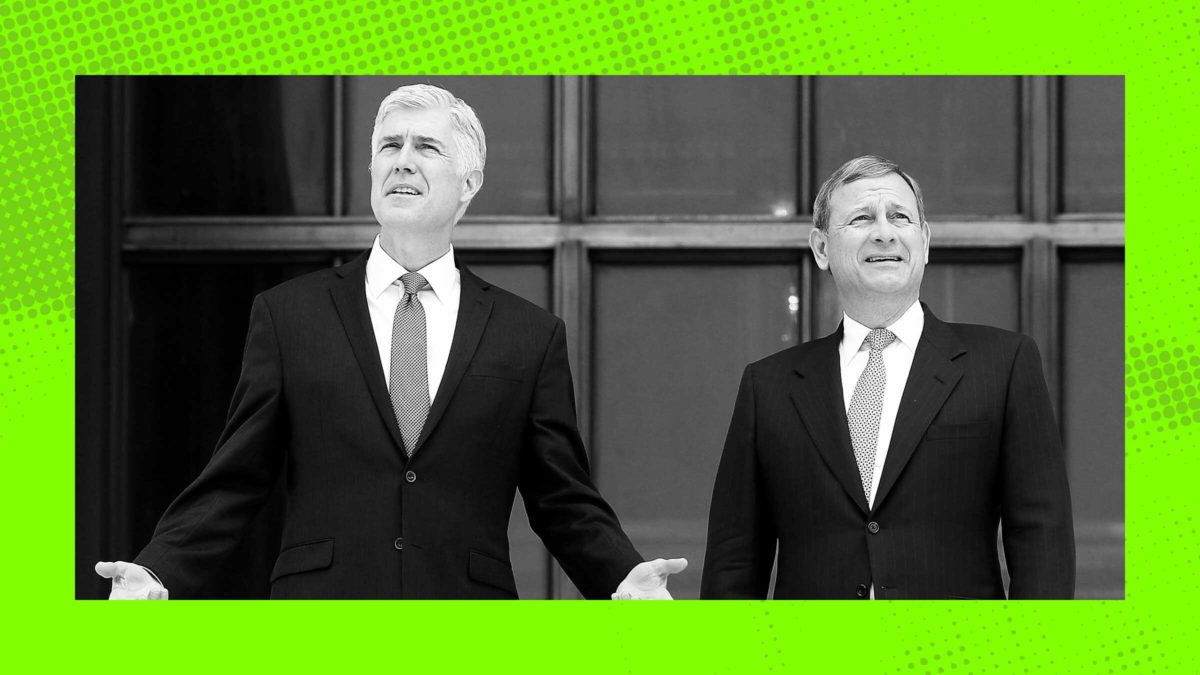The Supreme Court has once again started the summer by upending many Americans’ understanding of what rights are afforded to them under the Constitution. Our 50-year experiment with something resembling sex equality was dashed aside in Dobbs v. Jackson Women’s Health Organization. Our 200-year, already-rapidly-failing experiment with maybe not getting shot in public came to a screeching halt in New York State Rifle & Pistol Association v. Bruen. Examples abound.
Already, people are hurting because of the Court’s decisions. Drafting another blog post complaining about the vacant logic the conservatives on the Court use to impose their minoritarian ideology feels, to a certain extent, like throwing a water balloon at a forest fire. But despite what the David Frenches of the world might tell you, the work of this radical Supreme Court is not done. That’s because the Court’s use of “originalism” doesn’t just compel the most conservative result in every case; it also lets the justices tee themselves up as the only people in this country capable of answering the call.
Whenever the conservatives want to dispense with a constitutional argument they view as protecting “liberal” causes, they follow a pretty straightforward playbook. First, the conservatives define their inquiry as narrowly as possible. In Vega v. Tekoh, released a few days before Dobbs, Justice Samuel Alito held that your “right against compelled self-incrimination” is not at stake when a cop bullies you into testifying in violation of your Miranda rights, because the Miranda warning is not a right at all. Instead, Alito thinks Miranda is just a “prophylactic rule” used to “protect the Fifth Amendment right against compelled self-incrimination.” In Dobbs, Alito concluded the Court wasn’t examining the “right to decide whether to terminate a pregnancy”; it was only the more limited “right to obtain an abortion.” Narrowing constitutional questions like this serves only to help the Court skirt around any obstacle in their path to ruling how they want.

When you’re trying to look at some centuries-old documents but can’t zoom in any further on the PDF (Photo by Chip Somodevilla/Getty Images)
Next, the Court moves on to step two: Do an originalism. In Kennedy v. Bremerton School District from this term, Justice Neil Gorsuch concluded that the boundaries of the Establishment Clause “must be interpreted by reference to historical practices and understandings.” In Bruen, Justice Clarence Thomas concluded firearm restrictions conflicting with the “plain text” of the Second Amendment must be supported by evidence that it is “consistent with the Nation’s historical tradition of firearm regulation.” And of course, in Dobbs, Alito mandates that any due process protections not written out word-for-word in the Fifth Amendment be “objectively, deeply rooted in this Nation’s history and tradition.”
To answer these questions, the Court conducts surveys of what they say is the relevant historical material and compares it to the modern rights at issue through “reasoning by historical analogue.” Thomas’ opinion in Bruen spends 30 pages comparing and contrasting modern gun restrictions to those enacted in 1787 by rifling through a panoply of Anglo-Saxon statutes. To support his conclusion about the history of pre-viability abortion access, Alito’s Dobbs opinion cites treatises and laws from the 13th goddamn century, when the most common way to conclusively determine you were pregnant was feeling the fetus Rockette-kick inside you.
There are layers of bullshit buried beneath this mode of analysis. For one thing, it’s a barbaric way to determine your rights. As Yale Law Professor Reva Siege remarked in an op-ed for The Washington Post, the Court’s originalist approach “excuses [the Court] from considering whether politicians’ views of gender roles, in a period when women were disenfranchised, shaped the campaign to ban abortion, which of course they did.” The expressed ideology in these cases takes the same history we as a country applaud ourselves for moving past and weaponizes it against us.
More practically, the level of historical survey the Court conducts is just not something judges are qualified to do. Three years of law school teaches you very little, and none of it includes a crash course in the analytical methods historians use in their work. Your time as a law student isn’t much different from other academic disciplines: You pretend to read a bunch of cases, get badgered with questions every class by some decaying law professor, and take exactly one test (sometimes while hung over) at the end of the semester. Nothing about that experience trains you how to evaluate primary source documents like a historian, which is why law students make such embarrassingly bad gaffes when they try.
The Court’s myopic focus on history amplifies this problem. The more detailed the historical question, the harder it becomes to find centuries-old cases and statutes that specifically trace the lineage of some ethereal liberty to the present. Even so, every conservative justice believes themselves qualified to dig through old libraries with a kerosene torch like Nic Cage looking for morsels of evidence about the Second Amendment. No wonder every originalist opinion is met with long thinkpieces by actual historians kicking the shit out of the myriad analytical flaws.
But perhaps most crucially, this originalist framework rigs the game so conservatives only have to hear the cases and write the decisions they want. At a time when the Court is taking fewer and fewer cases, caseloads in federal courts have been skyrocketing since the 1970s. Most federal judges balance several hundred cases at a time , rotating between conducting hearings in court and researching and writing complex orders. By contrast, no single justice has written more than 40 opinions in a calendar year for the past decade, and Thomas is the only one to break 30. It’s at this moment the Supreme Court, in their dipshit wisdom, is mandating that each massively overworked federal district court conduct a thorough historical analysis for any potent constitutional claim that reaches their docket.

When you’re a judge charged with writing down all your qualifications to do history (Photo by Tom Williams-Pool/Getty Images)
Courts do not have the education, time, or resources to conduct these historical surveys adequately. The dissents in Bruen and Bremerton lay out how impossibly impractical this method of analysis is: how it “offers essentially no guidance for [government officials like] school administrators,” and “imposes a task on the lower courts that judges cannot easily accomplish.” In Bruen, Thomas responds that judges can rely upon the “historical record compiled by the parties.”
Attorneys, though, have no more experience cosplaying as historians than judges. Your average lawyer has no idea where to begin researching how our past restrictions on gun laws shape the present limits of the government’s authority. Thomas, by contrast, can push a big red button in his desk and force twelve sweaty Claremont Institute fellows to vomit out some shoddily researched nonsense on sodomy laws in a matter of weeks.
Therein lies the conservative justices’ trick: When the Court is deciding which cases to take, they can cherry-pick the ones they want and blame the necessity of their review on having to redo the historical “analysis” the lower court was too inexperienced and beat down to carry out. They can then use the mask of originalism to massage away any consideration of the disastrous effects of their ideology, all while complaining that the lower court hasn’t watched enough OAN to understand the Constitution. Thomas did so explicitly in Bruen, dismissing the lower court’s analysis as “inconsistent” with his preferred “historical approach.”
The Court as an institution—especially this Court as an institution—is not interested in finding the clearest, most historically accurate answer to legal questions, and wouldn’t know how even if they tried. The rigid implementation of originalism as the test for any and all constitutional questions lays bare what the conservatives are actually engaged in: the exercise of unchecked power. Until the composition of the Court changes, thanks to the framework the Court has built, the results of these exercises are only going to get worse.

